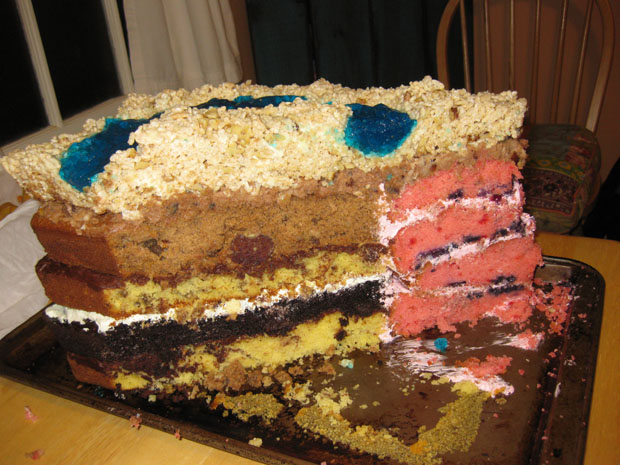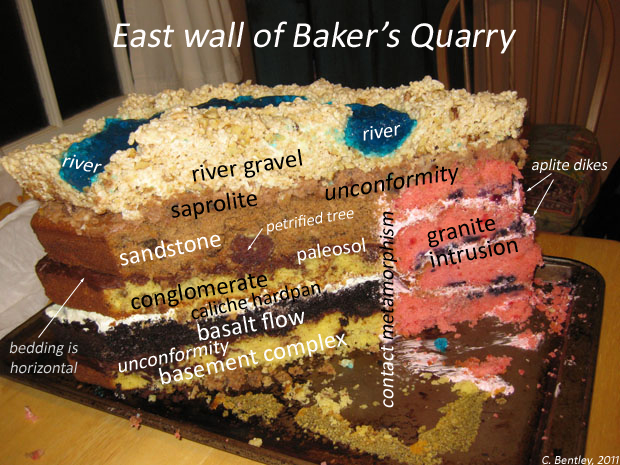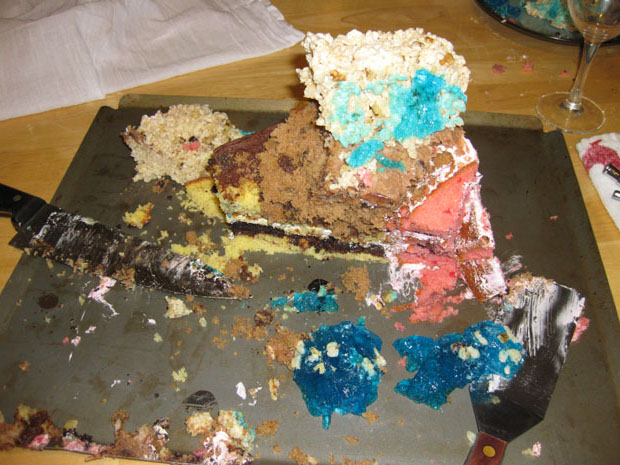In the field last weekend, around snacktime, I crossed the border from Candyland into Baked Alaska. There, I encountered an excavation into the strata of the region, as a local patisserie was mining for ingredients. Their work had exposed a beautiful cross-section of the subsurface. I documented the occasion with my camera and some intense field work. Time was short, as mining operations were in full swing. For posterity, I reproduce here for my geobaking colleagues the east wall of Baker’s Quarry:

Here is an annotated version, based on my field notes (which, it must be admitted, were difficult to read due to smearing with chocolate icing):

The processes it took to produce this particular arrangement of rock types must have been as follows: First, an ancient episode of mountain-building produced the swirled gneisses of the basement complex. Mafic foliations of amphibochocolate, bearing porphyroblasts of Ghiradellite, strike predominantly to the northwest, though they are in places folded isoclinally about axes which plunge steeply to the northeast. Ion microprobe dating of the Ghiradellite reveals a crystallization age of a couple of months ago, with a metamorphic age of Saturday morning around 9am, plus or minus half an hour. We interpret this metamorphic age as indicating the orogenic activity accompanying the construction of the superconfectinent Pan-gea.
A period of erosion must have followed, for a pronounced unconformity is observed atop the basement complex. Mixed in with the icing there are coherent crumbs of the basement complex. Atop this unconformity is a layer of chocolatey basalt, including mafic xenoliths. Columnar jointing is absent from this layer, though there are curious structures which resemble marks left by a butterknife spreading frosting. We interpret this volcanism as decompression melting accompanying superconfectinent breakup and the opening of the Strudel Sea. An arid climate must have predominated in the time after the eruption of the basalt, for we observe a layer of white frosting atop it. This is interpreted as a caliche hardpan.
A polymictic, matrix-supported conglomerate is next in the sequence, with a channel lag deposit at its base. There, we identified raisins, walnuts, and baking chips of several varieties. The provenance of these inclusions is enigmatic. We interpret the unit as a series of vanilla-flavored mudflows and river deposits.
A rich brown paleosol is seen atop the conglomerate, indicating the passage of time, stabilization of base level, and temperate climate. A sandstone unit overlies the paleosol. This unit is distinctive not only for its spicy aroma, but also for the presence of petrified logs from the date tree. An oblique section through one prone date log is visible at the base of the Spicecake Sandstone formation as exposed halfway up the east wall of Baker’s Quarry. This species was prominent in fluvial margins and floodplains of the North American continent beginning in the Hersheyian epoch and persisting into the Carbohydratian, though they are significantly less common from the WillyWonkaian forward. Elsewhere, radiometric dating has established this range as 10:15am until 1pm. This constrains the depositional age of the Spicecake Sandstone to somewhere in that stretch of geobaking time, meaning that the strata beneath it but above the basement complex have a maximum age of 9am and a minimum age of 1pm.
Cross-cutting all the units hitherto described is a potassic granite pluton, itself crosscut by numerous subhorizontal dikes of aplite. It is a striking pink color, almost too pink to seem natural. We have dubbed it the Strawberry Granite. Though the contact shown in the east wall of Baker’s Quarry is subvertical, mapping of the pluton in the third dimension reveals a circular outcrop pattern. The presence of blueberries and red candy nuggets suggest the magma was perafruitinous in composition. A zone of contact metamorphism, marked by strawberry icing, surrounds the intrusion. Geochemical fingerprinting of xenoliths of dried strawberries in the cake suggest wall rock stoping, perhaps sourced from a nearby box of Paul Newman’s “Sweet Enough” cereal. The intrusion does not appear to be temporally associated with any regional deformation, and thus we interpret it as anorogenic.
A period of uplift and erosion followed, producing an unconformity surface marked by a thick zone of saprolite. A large proportion of coconut flakes may be found in this unit. The modern Jell-O River was established over this weathered surface, bringing in a large quantity of gravel from the nearby Sticky Fingers Mountains. Dominated by Rice Krispies, this river gravel deposit also includes white chocolate chips and walnuts. A cement of marshmallow has incompletely lithified this unit, but the river continues to meander through it. Somewhat amazingly, the river hasn’t yet poured down into the quarry to fill it. This may have something to due with the frigid temperatures at the time of my visit — the river’s flow appeared quite gelid.
Historical records indicate that quarrying operations began in earnest around 9:30pm, although there is anecdotal evidence of small scale nibbling, particularly in the Strawberry Granite, prior to that time. Though only crumbs were removed, a few locals reported their findings to others. Resulting hype and rumor-mongering built up public anticipation to a frenzied hum. When the echoes of dinner had faded, industrial-scale excavations began at Baker’s Quarry.
Mountaintop removal made short work of the resistant upper layers, and the multiple sweetrata were soon severely eroded, with the unfortunate effect of destroying the outcrop for future scientific investigation. I’m pleased to have had the chance to document the formations exposed there during their brief period of existence.

——————————————————————————-
Got something to contribute to the Bake Sale? Remember that this Friday is the when the oven timer goes “ding!”


From the blog inanis et vacua, which I think is written by the author Jim Harrison, though he/she doesn’t make her/his identity too obvious.
“An apple strudel could, after all, be considered the kind of metamorphic rock that results from the application of heat at low pressure to sedimentary deposits of phyllo dough. Granted we don’t usually think of bakers as geological agents like erosion or volcanic eruptions, but the geology textbooks do consider bacteria and diatoms in this way and, under the hood, a macrobe isn’t much different than a microbe.”
Wow, Callan, that’s a pretty epic cake. I wonder if I’ll be the only one with a healthy entry in this month’s wedge….
Callan, you kill me! Also, you’re making me hungry. This is going to be the bestest, most painful AW evah.
Hmm, Baker’s Quarry is already taken. It is in Massachusetts. There is a cave in it, named appropriately Bakers Quarry Cave.
How about Baker’s Roadcut? Baker’s Highwall?
How about Baker’s Callan Gets To Call It Whatever He Wants Because He Made It?
🙂
Any plans for environmental remediation by the mining company?
What a remarkable locality! And so appetizingly documented! But what a shame that brutal “scientific” “investigations” have destroyed it, starting with casual “mountaintop removal.” Hah! Terricide is more like it! Still, I hope that good diagnostic specimens have been preserved in a museum drawer for future workers to snack upon–I mean, drool over–I mean, examine.
Still, many outcrops deserve better treatment. Consider the well-known Fruitcake Geological Preserve, untouched and pristine!
It’s great that you happened upon such a quarry prior to it being completely mined out (and who, might I add, was responsible for the mining?). Were any locals “up in arms” over the mining, or were they all for it?
For an open-pit mine, consider laying the walls back from the center outward next time, thus being able to calculate the stripping ratio while devouring the geology.
This is hilarious! When I was in college, a fellow student and I invited our beloved geology professor and his wife to dinner. We constructed the whole meal based on subjects he had taught, and dutifully drew detailed drawings of them just as we had done in class. The main meal was a seascape with a wave-cut cliff (mashed potatoes, I think), green beans for spartina patens, and a boulder pavement of meatballs. Dessert was the pièce de résistance — a multi-layer cake (at least 6 layers) — very colorful — and with different sediments or inclusions between each layer. The one I most remember (this was 50+ years ago!) was the one with animal crackers to replicate animal remains in a tar pit (think “La Brea”). Surprisingly, it all tasted delicious!